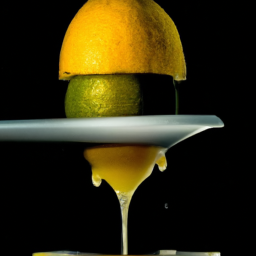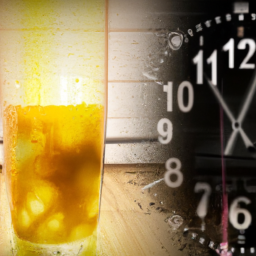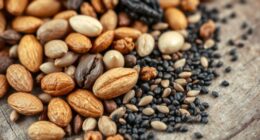When life gives you limes, it’s time to make some lime juice! But how many limes do you need to make a quarter cup of lime juice? Let’s explore this question in the article below.
So grab your lime squeezer and let’s get started! As the saying goes, ‘when in doubt, add lime.’ Lime juice is a versatile ingredient that can add a tangy and refreshing flavor to a variety of dishes, from cocktails to marinades to dressings.
But getting the right amount of lime juice can be tricky, especially if you’re not familiar with the measurement conversions. In this article, we’ll break down the factors that affect lime juice yield, how much juice you can get from one lime, and how many limes you’ll need to make a quarter cup of lime juice.
We’ll also explore different ways to measure lime juice, tips for buying and storing limes, substitutes for lime juice, and creative recipes that incorporate this zesty ingredient. So let’s juice it up!
Key Takeaways
- It takes about 2-3 limes to yield 1/4 cup of lime juice.
- Lime juice yield can be affected by factors such as the ripeness of the fruit and the juicing method used.
- Using a citrus juicer or hand-held reamer can help extract more juice than simply squeezing the lime by hand.
- Bottled lime juice or lemon juice can be used as a substitute for fresh lime juice.
Understanding Lime Juice Measurements
You’ll need to squeeze about 8-10 limes to get a cup of fresh, zesty lime juice. Lime juice is a great ingredient for adding tangy flavor to dishes such as ceviche, guacamole, and margaritas.
If you don’t have enough limes on hand, there are lime juice alternatives such as bottled lime juice or even lemon juice that can be used as a substitute. However, fresh lime juice is always preferred for its superior flavor and health benefits.
Speaking of health benefits, lime juice is packed with vitamin C, antioxidants, and other nutrients that can boost your immune system and promote healthy digestion. It can also be used as a natural remedy for a sore throat or cough.
So, next time you’re in the mood for a refreshing drink or need to add some zing to your dish, reach for some fresh lime juice. Just keep in mind that the yield of lime juice can be affected by factors such as the ripeness of the fruit and the juicing method used.
Factors Affecting Lime Juice Yield
If you want to maximize your lime juice yield, paying attention to factors like ripeness and juicing technique can make a big difference. The ripeness of the lime affects the amount of juice that can be extracted. A ripe lime will produce more juice than an unripe one. When it comes to juicing technique, using a citrus juicer or hand-held reamer can help extract more juice than simply squeezing the lime by hand. Additionally, rolling the lime on a hard surface before juicing can help loosen the juice pockets inside the fruit.
Another factor to consider when extracting and preserving lime juice is the temperature. Lime juice should be extracted and stored at room temperature, as refrigeration can cause it to lose its flavor and acidity. When preserving lime juice, it is important to use an airtight container to prevent oxidation, which can also affect the flavor and quality of the juice. By paying attention to these factors, you can ensure that you are getting the most out of your limes and preserving the quality of your lime juice for future use. With this in mind, let’s explore how much lime juice can be extracted from one lime.
How Much Lime Juice in One Lime?
Imagine taking a freshly picked lime and squeezing it with your hand. The tangy aroma fills the air as the juice drips down your fingers. One lime can yield approximately 1-2 tablespoons of lime juice, depending on its size and ripeness.
To get the most juice out of your lime, try microwaving it for 10-15 seconds or rolling it on a hard surface before squeezing. Another way to extract lime juice is to cut the lime in half and use a citrus reamer or juicer.
When it comes to using lime juice in cooking, there are plenty of alternatives if you don’t have fresh limes on hand. Bottled lime juice, while not as flavorful as fresh, can be a convenient substitute. Other options include using lemon juice or vinegar, which can provide a similar level of acidity.
Lime zest, the outermost layer of the lime peel, can also add a bright citrus flavor to dishes. Try adding it to marinades, dressings, or as a garnish for cocktails.
Transitioning into the subsequent section about ‘how many limes for 1/4 cup of lime juice?’, a common measurement in recipes, it’s important to note that the number of limes needed can vary based on their size and juiciness. However, on average, it takes about 2-3 limes to yield 1/4 cup of lime juice.
How Many Limes for 1/4 Cup of Lime Juice?
Get ready for a citrus explosion in your taste buds because it takes just a handful of these zesty green fruits to extract a quarter of a cup of the tangiest lime nectar you’ve ever tasted.
To make a 1/4 cup of lime juice, you’ll need approximately 4 to 5 medium-sized limes. The amount of juice you can extract from each lime will depend on its size and ripeness, but on average, one medium lime yields about 2 tablespoons of juice.
If you don’t have enough limes on hand, there are lime juice alternatives you can use instead. Bottled lime juice is a convenient option, but it may not have the same fresh flavor as freshly squeezed lime juice. You can also substitute lemon juice, which has a similar tangy taste and acidity.
In terms of health benefits, lime juice is a good source of vitamin C and antioxidants, which can help boost your immune system and protect against cellular damage. Additionally, lime juice can aid in digestion and may lower your risk of certain chronic diseases.
As you now know how many limes you need for a 1/4 cup of lime juice, the next step is measuring lime juice with kitchen tools.
Measuring Lime Juice with Kitchen Tools
Using a kitchen tool like a measuring spoon or small pitcher, it’s easy to extract the perfect amount of zesty citrus nectar for your recipe. Measuring accuracy is crucial in cooking, especially when it comes to acidic ingredients like lime juice.
Here are some tips on how to measure lime juice accurately using kitchen tools:
- Use a citrus juicer to extract lime juice from fresh limes.
- Use a measuring spoon to scoop the juice from the juicer and pour it into the recipe.
- If you don’t have a juicer, you can also use a fork to extract the juice by piercing the lime and twisting it back and forth.
- A small pitcher can also be used to extract juice from multiple limes at once.
- To ensure accuracy, use a kitchen scale to weigh the lime juice instead of measuring it by volume.
Alternative sources of lime juice are also available, such as bottled lime juice. However, the taste may not be as fresh and zesty as fresh lime juice.
Using Bottled Lime Juice
I personally prefer using bottled lime juice in my cooking because it saves time and effort. However, there are pros and cons to using bottled lime juice.
On the one hand, it’s convenient and consistent in flavor, but on the other hand, it may lack the freshness and complexity of freshly squeezed lime juice. To adjust for concentration, I recommend tasting the dish as you add the bottled lime juice and adjusting accordingly.
Pros and Cons
You’ll want to weigh the pros and cons before deciding whether to squeeze the cup of lime juice yourself or take the easy route and buy it pre-made. One of the biggest advantages of using bottled lime juice is convenience. It saves time and effort, especially if you’re making a large batch of margaritas or marinade.
Additionally, bottled lime juice is readily available year-round and can be stored in the fridge for months, so you don’t have to worry about buying fresh limes every time you need lime juice. However, there are some drawbacks to using bottled lime juice. One of the main concerns is the nutritional value.
Freshly squeezed lime juice contains more vitamins and minerals than the bottled version, which may have added preservatives and sugar. Moreover, bottled lime juice may not have the same flavor as fresh lime juice, which can affect the taste of your dishes. Therefore, if you’re looking for the best taste and health benefits, it’s recommended to squeeze the limes yourself.
When adjusting for concentration, keep in mind that bottled lime juice may be more concentrated than freshly squeezed juice. To dilute it, you can add water or additional ingredients to balance the flavor. Alternatively, if you’re using fresh lime juice, you may need to use more than the recipe calls for, as the lime may not be as juicy as you expected.
By experimenting with different ratios, you can find the perfect balance of lime flavor in your dishes.
Adjusting for Concentration
To balance the flavor of your recipe, it’s important to consider the concentration of the lime juice, which can vary depending on whether it’s freshly squeezed or from a bottle. If you’re using bottled lime juice, be aware that it may have added preservatives, which can affect the taste and acidity of the juice. In this case, you may need to adjust the amount of lime juice to achieve the desired level of acidity.
On the other hand, if you’re using freshly squeezed lime juice, you may need to adjust the measurement to account for the varying levels of acidity in different limes. Converting measurements can be tricky when it comes to lime juice, as the acidity can vary from lime to lime. A general rule of thumb is that one lime yields about 2 tablespoons of juice, but this may vary depending on the size and juiciness of the lime.
To adjust the acidity of your recipe, you can add more or less lime juice, or combine it with other acidic ingredients such as vinegar or citrus zest. By being mindful of the concentration and acidity of your lime juice, you can ensure that your recipe has the perfect balance of flavor.
Now, let’s move on to some tips for buying and storing limes.
Tips for Buying and Storing Limes
When purchasing limes, be sure to look for ones that are firm, plump, and have a bright green color. Here are some buying tips and storage ideas to help you get the most out of your limes:
- Choose limes that are heavy for their size. This indicates that they’re juicy and full of flavor.
- Avoid limes that have soft spots or bruises, as they may have already begun to spoil.
- Store limes at room temperature for up to a week, or in the fridge for up to two weeks. Keep them in a plastic bag or container to prevent them from drying out.
To get the most juice out of your limes, roll them on a hard surface before juicing to break down the membranes and release the juice.
Limes are a versatile ingredient that can add a bright, tangy flavor to a variety of dishes. From cocktails to marinades to desserts, there are endless ways to incorporate lime juice into your cooking. However, if you find yourself without any lime juice on hand, don’t worry – there are plenty of substitutes you can use instead.
Substitutes for Lime Juice
Looking for a tangy flavor alternative to lime juice in your cooking? Try these substitutes instead!
One great option is lemon juice, which has a similar bright, acidic flavor that can be used in many of the same recipes. You can also try using vinegar, especially white wine or rice vinegar, for a tangy kick.
Another creative option is to use green apple juice, which adds a slightly sweet and tart flavor that can be a great addition to marinades or salad dressings. When using these substitutes, it’s important to keep in mind the intensity of the flavor and adjust accordingly.
For example, lemon juice can be more tart than lime juice, so you may want to use slightly less than the recipe calls for. Additionally, think about creative lime flavor combinations that can be achieved with these substitutes.
For example, try using green apple juice in a ceviche recipe for a unique twist on a classic dish. When it comes to using lime juice in recipes, there are endless possibilities for incorporating this versatile ingredient.
Using Lime Juice in Recipes
When it comes to using lime juice in recipes, I find it to be an incredibly versatile ingredient. It adds a bright and tangy flavor to both sweet and savory dishes, making it a staple in my kitchen.
Lime juice is also a popular ingredient in cocktails and other beverages, adding a refreshing zing to any drink. With its many uses, there are endless possibilities for incorporating lime juice into your favorite recipes.
Sweet and Savory Dishes
Indulge in the perfect balance of flavors with our sweet and savory dishes, guaranteed to satisfy your taste buds. Lime juice is the perfect ingredient to add a tangy twist to both sweet and savory dishes.
The acidity of lime juice pairs well with sweet ingredients like honey and sugar, while also adding a zesty kick to savory dishes like tacos and marinades. When it comes to flavor combinations, lime juice can be used in a variety of ways to enhance the taste of your dishes.
For sweet dishes, try adding lime juice to a fruit salad or drizzling it over grilled peaches with honey. For savory dishes, lime juice can be used in marinades for chicken or shrimp, or added to a guacamole recipe for an extra burst of flavor. Get creative with your recipe inspiration and experiment with different flavor combinations to find the perfect balance.
Now, let’s move on to cocktails and beverages, where lime juice is a staple ingredient in many classic drinks like margaritas and mojitos.
Cocktails and Beverages
After exploring the world of sweet and savory dishes, let’s take a turn towards the world of cocktails and beverages. As someone who enjoys hosting parties and events, I know that having a selection of tasty drinks is a must. And what better way to impress your guests than with creative garnishes and non-alcoholic options?
When it comes to cocktails, the possibilities are endless. From classic drinks like margaritas and martinis to more unique concoctions like cucumber mojitos and spicy bloody marys, there’s something for everyone. One ingredient that can really elevate a drink is lime juice. But how many limes do you need to make a cup of lime juice? The answer is typically 8-10 limes, depending on their size and juiciness.
But don’t let the number of limes deter you from using this versatile ingredient. Lime juice can add a refreshing tang to any drink, from a simple gin and tonic to a complex tiki cocktail. And if you’re looking for non-alcoholic options, lime juice pairs perfectly with soda water or lemonade for a refreshing mocktail.
Get creative with your garnishes, too – try a sugar rim or a slice of jalapeno for a spicy kick. The possibilities are endless when it comes to incorporating lime juice into your beverage game.
Frequently Asked Questions
What are the health benefits of consuming lime juice?
Lime juice is a refreshing addition to any recipe, offering a burst of tangy flavor and numerous health benefits. It can improve digestion, boost immunity, and even aid in weight loss. Try adding it to marinades, dressings, or as a garnish for cocktails.
How does the quality of the limes affect the taste of the lime juice?
The quality of limes directly impacts the taste of lime juice. When sourcing limes for production, decisions on ripeness, freshness, and acidity levels must be considered. Experiment with different varieties of limes to enhance the flavor profile of dishes.
Can you freeze lime juice for later use?
Yes, you can freeze lime juice for later use in your Lime Juice Recipes. I recommend freezing it in ice cube trays for easy portioning. Add a lime juice cube to sauces, marinades, or cocktails for a burst of zesty flavor.
What are some unique ways to use lime juice in cooking or baking?
Lime juice is a versatile ingredient that can add a zesty kick to cooking and baking. Creative recipes like lime-infused guacamole or homemade limeade are perfect for using up excess limes. For cocktail ideas, try a refreshing mojito or margarita.
How does the acidity of lime juice affect the preservation of food?
The acidic properties of lime juice can be both beneficial and detrimental to preserving food. Lime juice, compared to other citrus juices, can provide a unique flavor profile in dishes such as ceviche or marinades.
Conclusion
Well folks, I hope this article has shed some light on the mystery of how many limes it takes to get 1/4 cup of lime juice. As we learned, the answer can vary depending on the size and ripeness of the limes, as well as the method of juicing used.
But here’s an interesting statistic for you: did you know that one medium-sized lime typically yields about 2 tablespoons of juice? That means you’ll need about 4-5 limes to get 1/4 cup of lime juice. Of course, this is just a general rule of thumb and your own mileage may vary.
Whether you’re using fresh lime juice in a classic margarita, a zesty marinade, or a tangy dressing, it’s important to measure accurately to ensure the right balance of flavors.
And if you’re feeling adventurous, don’t be afraid to experiment with different ways to incorporate this versatile citrus fruit into your dishes. From ceviche to key lime pie, the possibilities are endless!
Ilana has been a vegan for over 10 years. She originally made the switch for health reasons, but soon found herself becoming more and more passionate about the ethical and environmental implications of a vegan lifestyle. Ilana is the author of The Graceful Kitchen, a blog all about veganism. She loves to cook up delicious and nutritious vegan meals, and share her recipes with others who are interested in leading a cruelty-free life. Ilana is also a strong advocate for using whole foods as the foundation of a healthy diet, and believes that going vegan is one of the best ways to achieve this.










